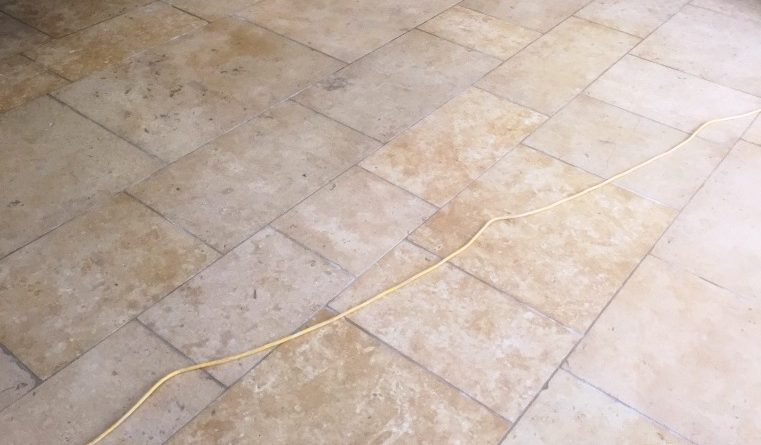Cleaning a Limestone Floor in a 14th Century Oxfordshire House
I was asked to clean the Limestone tiled floor of a very old house in the Village of Radcot which is close to the River Thames and dates to the 14th Century. Being close to a river is very scenic but can be problematic and I was told the house had experienced flooding in recent years.
Whilst the Limestone floor clearly wasn’t as old as the house it was definitely in need of some attention to remove the dirty that had become ingrained into the pores of the stone and restore its appearance.

Cleaning Limestone Floor Tiles
My first step was to let the floor soak for ten minutes in a strong dilution of Tile Doctor Pro-Clean, which is a strong Tile and Grout cleaner. The product was then scrubbed into the floor using a deck brush to remove any surface dirt. I also took the opportunity to clean up the grout before rinsing off the now soiled cleaning solution with water and extracting it with a wet vacuum.
Next I turned my attention to the stone tiles which would need to be stripped back, re-honed and then sealed to protect them. I find the best way to achieve this on stone is through the application of a set of Diamond encrusted burnishing pads.
I started the burnishing process by fitting a coarse 400 grit no.1 burnishing pad to a floor buffer and running at a slow speed, applied the pad over the whole floor. This coarse pad is designed to strip off old coatings and dirt from the tile. You use a little water to help lubricate and once complete it’s necessary to rinse the area with water to remove the soil that is generated. The next step is to start building back the polished surface with the 800 and then 1500 grit pads which are applied in the same manner.
This floor was left to dry before moving onto the final stage of the polishing process which is to apply the very fine 3000 grit which further restores the appearance of the Limestone tile. This last pad is applied dry with a small amount of water sprayed onto the surface to help bring up the shine.
Sealing Limestone Floor Tiles
With the floor dry I moved onto sealing the tiles in-order to protect them from dirt and staining. I used a couple of coats of Tile Doctor Colour Grow for this purpose as this particular sealer enhances the natural colours in the stone. It’s also an impregnating sealer that works by occupying the pores in the stone thus preventing dirt from becoming ingrained in the stone.
My pictures of the floor are not brilliant but hopefully you can see how much more colourful the floor now looks.

Source: Limestone Tile Cleaning and Polishing Service in Oxfordshire
